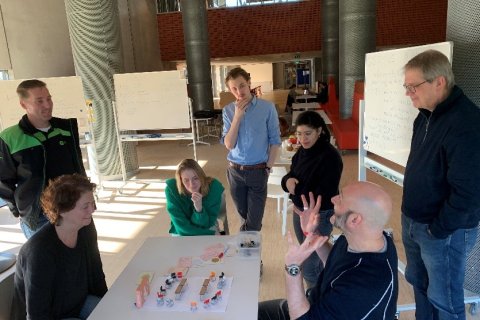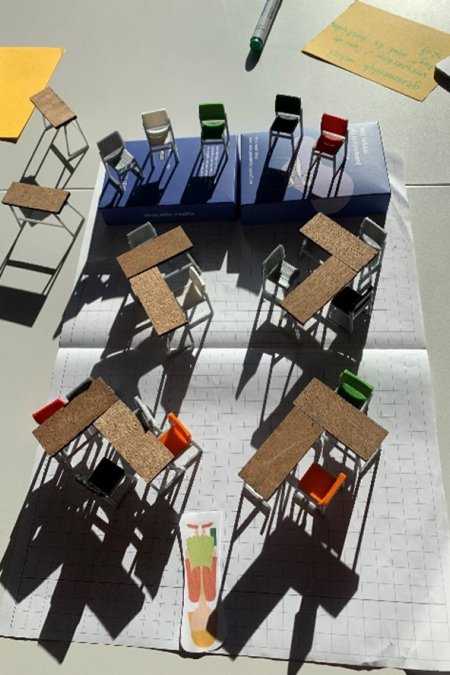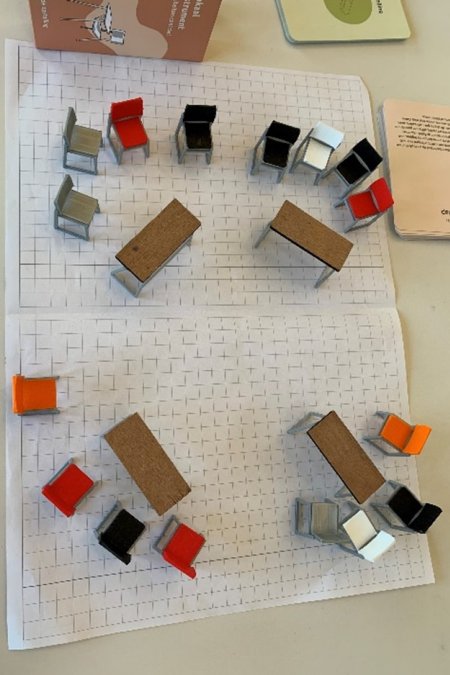Review meeting The Future is now; how can we improve our use of existing learning spaces?

In the Future Learning Spaces project, we develop innovative learning spaces, in cooperation with teachers and students. Examples are the Hybrid Active Learning Classroom, the Virtual Classroom and the Learning Plaza. Users are positive about these innovative spaces, and would like to make more use of them. However, there are only 5 of these types of learning spaces, and developing new spaces takes time. For now, the majority of education takes place in standardized classrooms and workgroup rooms.
In the Co-Creation Community meeting, held on the 8th of February, we brainstormed about how we can improve our use of the standardized spaces, to fit active and cooperating learning.
Firstly, we determined the flaws which limit the current spaces. Some examples of these flaws for the regular classrooms were that the furniture was stuck in place, and the formation of the rows limit the possibilities of different methods of working and limit the interaction between student and teacher. In workgroup spaces, the participants mainly had issues with the low amount of square meters per student, an excess of tables in too small of a room, the standard row- or u-formation of the tables, furniture not being able to be easily moved or even being stuck in place, the teacher's desk being stuck in place, and the lack of learning facilities like whiteboards or whiteboard markers.

After this, we split up into groups to find solutions to improve active and cooperative learning in these workgroup spaces, despite their flaws. With the help of inspiration cards, the groups firstly chose which learning goals they wanted to achieve and which learning activities/work methods they wanted to employ to achieve them.
Next, they used miniature furniture to build table formations that could fit these work methods. This yielded an interesting discussion, and surprising table formations. One of the groups chose a work method in the form of a carousel, where each time a student rotated to a different group. To achieve this, a table formation was considered that had the tables fitted in a windmill (or L) formation, with the teacher stood in the middle. This made it easy for the students to cooperate within groups, and simultaneously made space for movement; for students to move between different tables for each rotation, and for the teacher to give support at different tables.

The other group chose, among other things, for a work method of two groups of students having a literal stand-off. The tables are set to the set for this formation (or could, in the case of a lack of space, be put between the two groups) and the chairs are put opposite to each other in two rows. The students that are having a discussion, are stood in the middle, opposite to eachother (with the possibility of a moderator next to them), and the other students are part of the audience and are seated; students can easily swap roles/places.
The importance of thinking about, and experimenting with, different table formations while preparing a lecture became clear; to stimulate active and cooperative learning.
Finally, the participants were asked to fill in an exit ticket, containing 3 things they learned in the meeting, 2 things they would be implementing themselves in the near future, and 1 subject for the next meeting. A subset of the reactions:
3 things they learned in the meeting:
- How much impact the formation of tables can have
- You gain ideas from other, so share more with eachother
- Cooperative learning can be a challenge with the existing room formations in some cases
- Education/work groups do not have to be seated, standing up is activating
- Flexibility in a space seems to be the biggest pro for all spaces
2 things they would be implementing themselves in the near future
- More cooperation in working groups
- More experimenting with space formations in 'regular' spaces
- More thinking about different working methods in a work group
1 subject for the next meeting:
- Game Based Learning: what does a space need to comply with? Gaining experience with GBL
- Continue what was done today
Did you gain experience with working methods and formations in a standardized workgroup space, which you want to share? Send a message to fls@uu.nl!
The next meeting of the SIG/CCC LS is on Thursday the 6th of April, 12:00-13:30. Note it down in your calendar!
